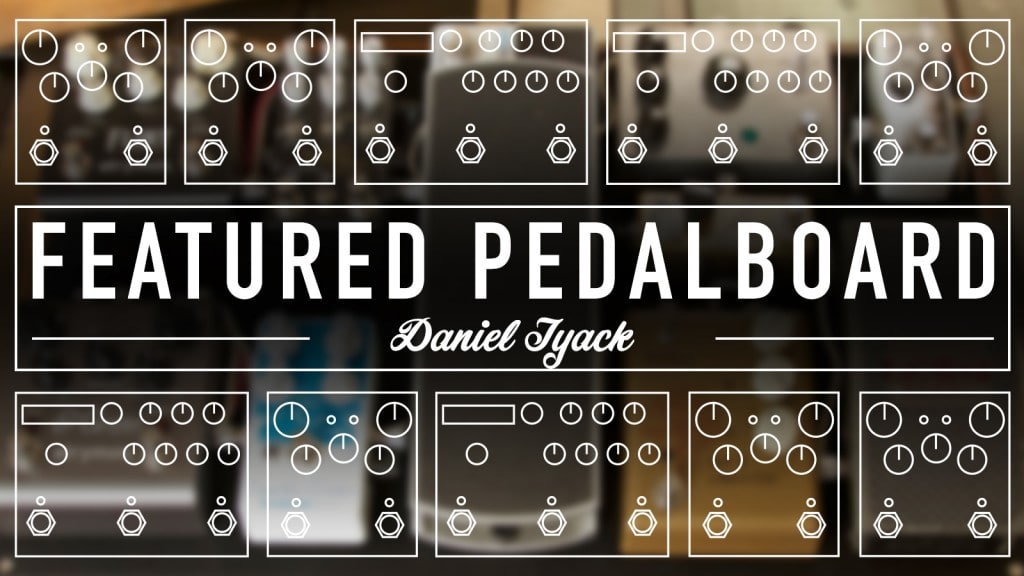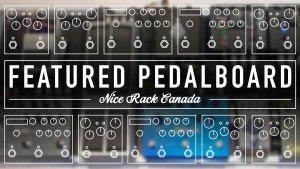
Pedalboard Feature: Matthew Stevens
Jazz guitarist Matthew Stevens just released his debut album Woodwork, after working on numerous albums with Walter Smith III, Justin Kauflin, and Harvey Mason. Recently,
Free US Shipping On Orders Over $49
Easy 30-Day Returns
Financing Available Through ![]()

 Daniel Tyack has been building pedalboards since his high school days and when demand grew, he opened up his own shop Salvage Custom in 2012. Read more below to learn about Daniel’s pedalboard builds and about his own personal pedalboard.
Daniel Tyack has been building pedalboards since his high school days and when demand grew, he opened up his own shop Salvage Custom in 2012. Read more below to learn about Daniel’s pedalboard builds and about his own personal pedalboard.
What is the first thing you take into consideration when getting ready to build a new board?
If it’s a board we plan on listing for sale then it’s pretty simple, I just build something I would like. My overall philosophy is to build things that I like so it works out pretty well for me! If it’s a custom board I generally consider what would be the best bet for the customer. Often times people get pretty excited about a custom build and they want to pull out all the stops. I do my best to talk them down a bit and say no to stupid stuff. Simplicity trumps bells and whistles in the long run and I want customers to be happy for a long time! I also chat with customers about their other gear and try to find out what kind of vibe they like. My goal is to always match a customer with a rig that’s perfect for them.
Tell us a bit about your pedalboard crafting style.
My crafting style is self learned and a lot of techniques were either made up or the product of a series of fantastic mistakes. When it comes to a build I do however take a lot of care to hand pick timbers, lay out wood grain and match tweed finishes to different species of wood. We’ve made a lot of cutting and routing jigs to streamline the process but there’s still a ton of hand crafting involved. Everything starts from raw materials and Matt and I do all of the work in house.
Tell us about your personal pedalboard.
Oh man… This is a tricky one. My board changes almost every week and I have a couple different size boards that I use. There are a few pedals that are almost always on the board but generally everything is subject to rotation. The size varies from about 6 to 13 pedals and what gets used really depends on where I’m playing. More often than not I’ll want to use one pedal then I end up changing everything else up just to make the layout work. My El Capistan and Flint are staples along with a tuner and San B from Push + Pull Pedals. You’ll seldom see my board without a fuzz and I’ve been really enjoying weird modulation stuff lately.
Do you usually play a specific style or do you like to explore different styles? How does your pedalboard help with that?
I primarily play in church and I’m more than happy to play other gigs when I get hired out. Luckily the churches I play for all have fantastic musicians and I’m given a lot of creative freedom. It’s a heck of a lot of fun to work fuzz, ring mod and other aggressive effects tastefully into a set. If ever I’m getting the least bit bored my pedals are the first thing I change around. My pedalboard is a massive source of inspiration. Sometimes I’m content to just play with no effects on and sometimes it gets messy! Having options is great for inspiration.
What is your signal path?
Though my pedals change week to week the signal path stays pretty much the same. It’s generally something like this: Fuzz, Drive, Compression, Volume Pedal (buffered), Modulation, Delay, Reverb. I like keeping the dirt first in line to keep them as sensitive as possible to pick attack / guitar volume control and I very often leave a dirt pedal on and adjust how clean it is with the guitar volume knob. My current rig (see pictures) goes like this: FX-17 Wah, Sputnik Mini Fuzz, San B., SP Comp, Fairfield Circuitry Randy’s Revenge, Volume Pedal (Tuner Out), Chase Bliss Warped Vinyl, Earthquaker Devices Dispatch Master, El Cap (stereo), Flint (stereo). It’s powered with a Dunlop MC403 + DC Brick and wired with Lava Tightrope wire. The 20×13 board is made from a very special piece of English Walnut that was a gift from Bob Taylor and the case is our Bourbon Burst finish.

If you had to stick with one set up, what would it be?
As much as I like to change things up this one is pretty easy and one I often go back to. Pedals and signal chain go like this: Push+Pull Pedals Sputnik Fuzz, Push+Pull Pedals San B., Origin Effects Cali76 (Comp), Volume Pedal (Buffered, tuner out), Strymon El Cap, Strymon Flint.
What is a good tip you can give people that are thinking about a new pedalboard?
Simple is better. Don’t put stuff on your board just to fill space. A crappy pedal that you don’t really like using is better left on the shelf. If it doesn’t make you happy to turn it on then take it off the board.
Subscribe to our newsletter to be the first to hear about new Strymon products, artist features, and behind the scenes content!

Jazz guitarist Matthew Stevens just released his debut album Woodwork, after working on numerous albums with Walter Smith III, Justin Kauflin, and Harvey Mason. Recently,

Andy Othling is a guitarist from Albuquerque, New Mexico who writes and records his own music under the name Lowercase Noises and plays with bands

We recently heard from pedalboard builder Mike Vegas of Nice Rack Canada, and he gave us the story behind a challenging job to create a
One Response
The Salvage Boards are awesome, I hope the Builder starts a new Company, truly a work of art and worthy of Strymon Pedals.